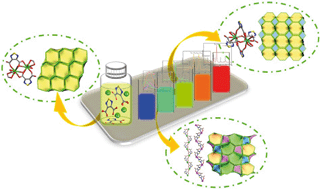Rational design and synthesis of a series of 3D lanthanide metal–organic frameworks with different structures driven by reaction conditions†
Abstract
Twelve novel three-dimensional (3D) lanthanide metal–organic frameworks with formula {[LnK(C4N2O4S)2(H2O)2](H2O)0.5} (Ln = La (1), Ce (2), Pr (3), Nd (4), Sm (5), Eu (6), Gd (7), Tb (8)), {[Ln2K2(C4N2O4S)2(C4O4H2)2(H2O)4](H2O)} (Ln = La (9), Ce (10)), and {[Ln2(C4N2O4S)3(H2O)](H2O)} (Ln = La (11), Ce (12)), are solvothermally synthesized by reacting the 1,2,5-thiadiazole-3,4-dicarboxylate (H2tdc) ligand with the corresponding lanthanide nitrate. These compounds exhibit three different types of structures which changed from nonporous to open-framework MOFs by adjusting the reaction conditions. Compounds 1–8 (type I) with a moc topology are constructed of 1D zigzag chains and pillared water molecules. Fumaric acid (Fac) as the coligand is introduced in the reaction to replace the pillared water and link similar zigzag chains to assemble compounds 9 and 10 (type II) with a dia topology. Compounds 11 and 12 (type III) with the chiral space group exhibit 1D right/left helical chains along the b axis, and the helical chains alternatively link together to form 3D frameworks with a new (3,4,5)-connected topology. The luminescence study shows that compounds 5, 6, 8 display intense orange, red and green luminescence and exhibit typical Sm3+, Eu3+ and Tb3+ ion emission, respectively. Furthermore, compounds 1, 7, 9 and 11 also exhibit intense green and blue luminescence arising from the H2tdc ligand.


 Please wait while we load your content...
Please wait while we load your content...